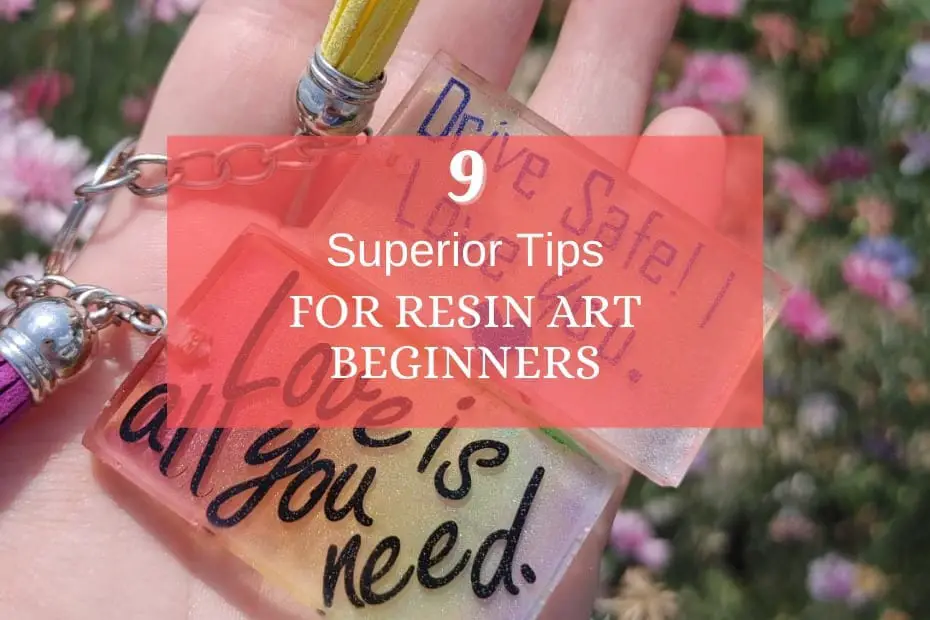Crafting with resin is growing in popularity. It’s a relatively simple art form, but there are many wonderful techniques that can enhance the process. As a beginner, it may seem a bit complicated to get started. That’s why I am here to help! If you use these 9 superior tips for resin art beginners, you will be making beautiful resin art to keep or sell in no time!
As an Amazon Associate, this post contains affiliate links, for which I may be compensated a small amount if you click on one and purchase something through it. This is at no extra cost to you.
Table of Contents
1. Figuring Out What Resin To Use + All Supplies Needed
Of course, this will be a big decision if you are just starting out. You may not even know that different types of resin exist. Here are the types you should know about.
Epoxy Resin is the most commonly used resin for crafting and is by far the easiest to work with. I recommend this specific type of resin if you are just starting out.
What You Need To Start Working With Resin Immediately
- Resin and hardener
- Measuring cups
- Mixing cups
- Gloves
- Stirring sticks
- Mould(s)
- Toothpicks
- Protective cover for your table (silicone mat)
- Heat gun or lighter
- Well-ventilated space
- Respirator mask (optional but recommended)
- Optional: Resin colorants, glitter, dried flowers, beads, heat mat, disposable pipettes, baby wipes
Benefits of working with Epoxy Resin
- Longer Shelf Life
- Not Affected By Many Environmental Factors (Such As Humidity)
- Longer Pot Time (How Long You Can Work With It Before It Hardens)
- Can Be Mixed Easily With (Acrylic Paint, Mica Powder, etc.)
- Most Epoxy Resin Will Dry Clear (Less Yellowing)
- Less Harmful Than Other Types Of Resin
Polyester Resin is superior to epoxy resin because it dries much harder and is clearer overall. However, I do not recommend it for beginners because the pot time is drastically less than that of Epoxy Resin. This gives you only a short amount of time to work with it. This would not be good for someone new to resin who is still slowly getting the hang of things.
Benefits Of Working With Polyester Resin
- Cheaper
- Dries Harder And Clearer
- Can Be Buffed And Shined More Easily
Polyurethane Resin is similar to polyester resin in that it dries extremely hard with even fewer curing issues. However, it is moisture sensitive. Climate and using too much liquid dye could jeopardize your projects. Be sure to use a colorant designed for this type of resin.
Benefits Of Working With Polyurethane Resin
- Dries Hard With Fewer Curing Issues
- High Heat Resistance After Curing
2. Proper Safety
Always practice proper safety when handling and breathing around resin. Most resin has toxic fumes and is quite poisonous. Therefore, you do not want to breathe in or allow resin to contact your skin.
I highly recommend 3 important pieces of safety equipment for anyone working with resin, not just beginners.
- Blue Nitrile Gloves
- Safety Goggles/Glasses
- A Respirator
If you use these 3 things, you can safely work with your resin without having an unfortunate accident, such as inhaling fumes, getting resin all over your skin, or splashing it into your eyes.
Click Here to Get Resin Safety Equipment Right Now on Amazon
3. How To Mix Your Resin
Mixing resin may seem simple enough, but there are ways to make it much more efficient. Many epoxy resins will require you to use 1 part resin to 1 part hardener. However, be sure to check your specific resin kit for directions and clear measuring procedures. Most of the time your kit or bottles will give you the clearest instructions based on the product.
If you are, in fact, using a one-part resin to one-part hardener kit, here are a few tips for you.
Estimate your project by volume. The closer you are, the less resin you will waste. Resin isn’t exactly cheap so saving where you can is great.
Let’s give an example.
I am making a resin coaster that requires roughly 40 milliliters.
I will then need 20 milliliters of resin and 20 milliliters of hardener for this project to equal my 40 milliliters needed for the coaster.
Make sure the measuring cups you use for your resin are marked clearly so you can always get your amounts accurate. I recommend measuring your resin and hardener separately rather than in the same cup so you can be sure your measurements are correct. Pour any excess back into your bottles.
4. Pouring Resin
My biggest tip for resin art beginners is to take your time when pouring resin. Resin sometimes tends to come out quicker than you are ready for. If you are unsteady when pouring resin, you can use large plastic syringes or droppers, depending on your project. Be sure not to overfill your resin molds.
When resin leaks onto the outside of a mold, you can end up with unsightly appendages attached to your project, which creates more unnecessary work for you. It can even ruin your project completely if you cannot remove it without destroying your work.
Take your time and be as careful as possible. Pour slowly and attentively.
Also, if you’ve noticed, the resin is extremely sticky, and it adheres to many surfaces. Once it hardens on certain surfaces it is nearly impossible to remove.
If you want to know what materials epoxy resin won’t or will stick to you can check out this helpful post. – “What Does Epoxy Not Stick To?”
5. Removing Bubbles
When working with resin, you will notice bubbles. They often begin in the stirring and mixing process. Once you pour the resin, you will notice many bubbles on the surface. Some will be large and unsightly, while others may be small and throughout the resin artwork.
The best way to remove bubbles is to run a heat gun over the surface of your resin project. Hold the heat gun a bit away, but enough to blow on the surface. You will almost instantly see many of the bubbles popping and vanishing.
Be sure not to hold the heat gun too close to your work as it may blow out your resin and ruin your work. Use care, and you will notice that as your resin cures, it has fewer bubbles.
6. Curing Your Resin Art
All resins are different, but many epoxy resins require the same kind of environment to cure. You will want a temperature that stays relatively consistent and does not fluctuate. A room where the climate is well controlled to about 70-75 degrees Fahrenheit is typically best suited. You do not want to place your resin in a cold or damp place.
If the temperature is below 70 degrees you may notice that the resin does not cure at all. Some resins are made differently, however, and can withstand lower temperatures.
Be sure to cover your resin piece with a cardboard box or something similar to prevent debris from falling in it while it is still curing. I cannot count the number of times cat hair has ended up in my artwork!
7. Sanding Your Resin Projects
This is an optional step but typically necessary to a certain degree. Many times, your resin artwork will cure with sharp edges. I recommend wet sanding your resin art starting with around 150 grit wet/dry sandpaper. Simply pour a bit of water onto the paper or wet the art piece itself.
In a circular motion, rub your resin art piece onto the surface of the sandpaper until the sharp edge is flat or dulled. You will notice that your resin piece now has a milky color in that area.
I recommend moving up to 400 grit and repeating the process all the way up to a grit to 1000 or even 2000. Sanding can take a lot of time, but you have to sand gradually to reduce the appearance of the scratches you’ve made. Here is a tutorial video that I really like for sanding resin pieces that may help you get a better understanding.
8. What Can You Make With Resin?
If you are a beginner with resin, you may wonder what types of things you can make with it. Here is a list of the most common things you can make with resin.
- Coasters
- Necklaces
- Earrings
- Charms
- Keychains
- Combs
- Trays
- Jewelry Boxes
These are just a few easy things you can make with your resin. There are all kinds of silicone molds out there to try out with your resin! Many of these items can be sold online.
9. Where Can I Sell My Resin Art?
If you are new to crafting with resin and art and curious about where to sell your artwork, there are a few ways to start. My best recommendation is to open your very own Etsy shop. Simply download the Etsy app on your phone or access it on a desktop.
Create your very own storefront with an appealing name and fill out all the information there. List your resin artwork with a great description and amazing pictures.
You can also sell your work online with eBay or an integrated shop on your website.
I hope this helps you get started with resin as a beginner.
There are so many things to discuss about resin, but this should get you off to a great start! Resin is one of my favorite things to work with and I love sharing tips and advice with others about it. You can do so much with it! If you really liked this post you may like a few of my other resin and craft posts!

